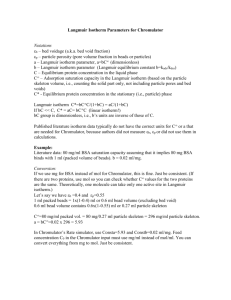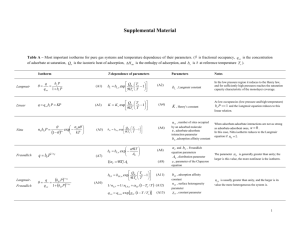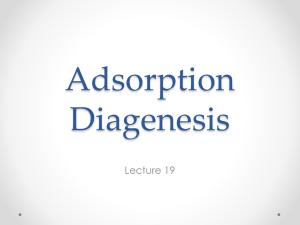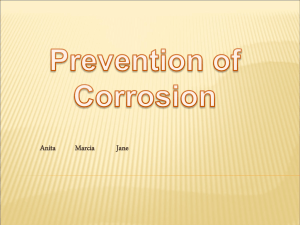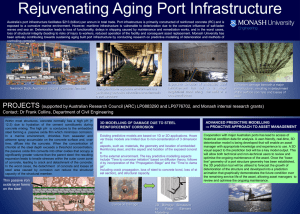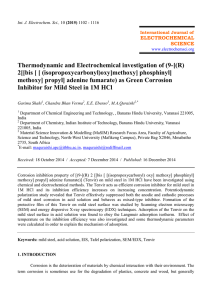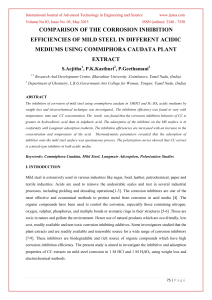A theoretical study on corrosion inhibitors: Effect of electronic
advertisement
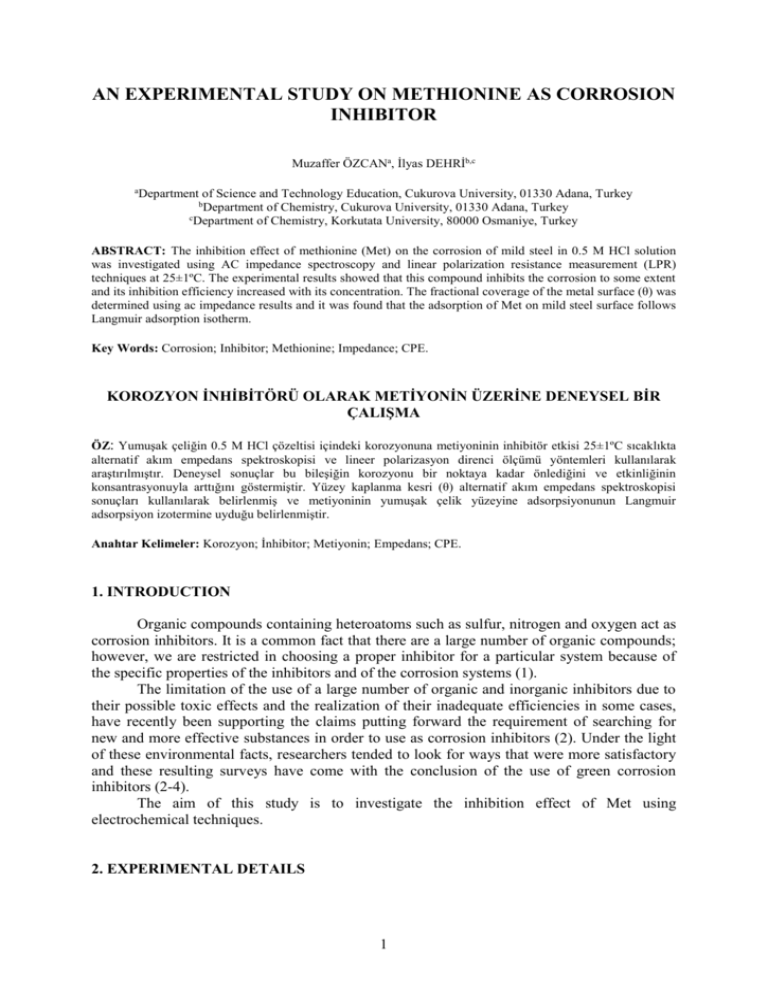
AN EXPERIMENTAL STUDY ON METHIONINE AS CORROSION INHIBITOR Muzaffer ÖZCANa, İlyas DEHRİb,c a Department of Science and Technology Education, Cukurova University, 01330 Adana, Turkey b Department of Chemistry, Cukurova University, 01330 Adana, Turkey c Department of Chemistry, Korkutata University, 80000 Osmaniye, Turkey ABSTRACT: The inhibition effect of methionine (Met) on the corrosion of mild steel in 0.5 M HCl solution was investigated using AC impedance spectroscopy and linear polarization resistance measurement (LPR) techniques at 25±1ºC. The experimental results showed that this compound inhibits the corrosion to some extent and its inhibition efficiency increased with its concentration. The fractional coverage of the metal surface (θ) was determined using ac impedance results and it was found that the adsorption of Met on mild steel surface follows Langmuir adsorption isotherm. Key Words: Corrosion; Inhibitor; Methionine; Impedance; CPE. KOROZYON İNHİBİTÖRÜ OLARAK METİYONİN ÜZERİNE DENEYSEL BİR ÇALIŞMA ÖZ: Yumuşak çeliğin 0.5 M HCl çözeltisi içindeki korozyonuna metiyoninin inhibitör etkisi 25±1ºC sıcaklıkta alternatif akım empedans spektroskopisi ve lineer polarizasyon direnci ölçümü yöntemleri kullanılarak araştırılmıştır. Deneysel sonuçlar bu bileşiğin korozyonu bir noktaya kadar önlediğini ve etkinliğinin konsantrasyonuyla arttığını göstermiştir. Yüzey kaplanma kesri (θ) alternatif akım empedans spektroskopisi sonuçları kullanılarak belirlenmiş ve metiyoninin yumuşak çelik yüzeyine adsorpsiyonunun Langmuir adsorpsiyon izotermine uyduğu belirlenmiştir. Anahtar Kelimeler: Korozyon; İnhibitor; Metiyonin; Empedans; CPE. 1. INTRODUCTION Organic compounds containing heteroatoms such as sulfur, nitrogen and oxygen act as corrosion inhibitors. It is a common fact that there are a large number of organic compounds; however, we are restricted in choosing a proper inhibitor for a particular system because of the specific properties of the inhibitors and of the corrosion systems (1). The limitation of the use of a large number of organic and inorganic inhibitors due to their possible toxic effects and the realization of their inadequate efficiencies in some cases, have recently been supporting the claims putting forward the requirement of searching for new and more effective substances in order to use as corrosion inhibitors (2). Under the light of these environmental facts, researchers tended to look for ways that were more satisfactory and these resulting surveys have come with the conclusion of the use of green corrosion inhibitors (2-4). The aim of this study is to investigate the inhibition effect of Met using electrochemical techniques. 2. EXPERIMENTAL DETAILS 1 The working electrode was cut from a mild steel rod (C,0.11; Mn,0.45; Si,0.25; S,0.050; P,0.040 and remainder iron) and inserted to polyester resin leaving only 0.196 cm2 of the surface area exposed to the corrosive solution. The electrolyte was 0.5M HCl solution without and with various concentrations (0.5, 1, 5 and 10 mM) of Met. Prior to each experiment, the working electrode was mechanically polished with a series of emery papers down to 1200 grade to a mirror finish, degreased in acetone, rinsed with bi-distilled water and dried with soft paper then immediately inserted into the glass cell containing 100 mL of solution. All the experiments were done at 25±1°C in solutions open to the atmosphere under unstirred conditions after 30 min of exposure time. AC impedance spectroscopy measurements were performed in 100kHz-10mHz frequency range using a CHI 604A AC electrochemical analyzer. Impedance data were obtained at the corrosion potential (Ecorr) of the working electrode measured against a Ag/AgCl reference electrode using a 5mV rms sinusoidal perturbation. A platinum counter electrode with 1cm2 surface area was also used. The impedance parameters were calculated by fitting the experimental results to an equivalent circuit using ZView software from Scribner Associates, Inc. Polarization resistance measurements were carried out at -10mV to +10mV vs. Ecorr at a scan rate of 1mVs-1. 3. RESULTS AND DISCUSSION Fig.1 shows typical set of complex plane plots of mild steel in 0.5M HCl solution in the absence and in the presence of various concentrations of Met. 1. Blank 2. 0.5 mM Met 3. 1 mM Met 4. 5 mM Met 5. 10 mM Met Zimag(Ω.cm2) ─ Fit Results ▪ Experimental Results Zreal(Ω.cm2) Fig. 1. Complex plane plots for mild steel in 0.5M HCl solution in the absence and in the presence of various concentrations of Met. All of the impedance spectra obtained in the absence and in the presence of inhibitors consist of one depressed capacitive loop corresponding to one time constant in Bode plots. In order to obtain accurate results the analysis of complex plane plots was done by fitting the 2 experimental results to the equivalent circuit given in Fig. 2, which has been used previously to model the mild steel/acid interface (5-8). It is obvious from Fig. 1 that the fit results generally present the similar shape with the ones of experimental results with an average error of about 2.6% in all the cases. This clearly indicates that the equivalent circuit used to model the systems under investigation is the most appropriate one. Fig. 2. Equivalent circuit model represents the metal/solution interface. CPE constant phase element, Rct charge transfer resistance, Rs solution resistance. The impedance parameters derived from the complex plane plots are given in Table 1. The Rp values were also measured at working electrode conditions using the polarization resistance measurement technique and are given in the same table. Rct(Ωcm2)b Rs(Ωcm2)b Rp(Ωcm2)a -Ecorr(V) Ci(mM) Mol. Table 1 Impedance parameters derived from complex plane plots in 0.5M HCl solution in the absence and in the presence of various concentrations of Met. CPEdl Yo(x106snΩ-1cm-2) Blank Met. Cdl(x106sΩ-1cm-2)c IE%d n(0-1) - 0.536 71.4 11.0 63.4 60.0 0.889 30.4 - 0.5 0.531 149.3 9.0 126.2 45.4 0.892 24.2 50 1 0.530 196.1 8.8 172.0 38.5 0.891 21.1 63 5 0.527 357.1 8.8 381.8 25.4 0.893 14.8 83 10 0.522 384.6 8.9 419.5 25.3 0.896 15.1 85 a:Rp from polarization resistance measurements. b:Rs and Rct from complex plane plots. c:Yo values were converted into Cdl as described in Ref. 9. d:Values of percent inhibition efficiency (IE%), were calculated using Rct from complex plane plots. Table 1 shows that the addition of the inhibitors into the corrosive solution causes to an increase in the charge transfer resistance and a decrease in the double layer capacitance. The decrease in Cdl, which may result from a decrease in local dielectric constant and/or an increase in the thickness of the electrical double layer (10,11), shows that the inhibitor was adsorbed on the mild steel surface. Among the most frequently used adsorption isotherms, the Langmuir adsorption isotherm exhibited the best fit to the experimental data (Fig. 3). The Langmuir adsorption isotherm can be expressed as (12): C 1 C θ K (1) 3 where θ is fractional coverage of the metal surface, C is the inhibitor concentration in the electrolyte and K is the equilibrium constant for the adsorption/desorption process. The value of ∆G°ads was found as -29.15kJ/mol for Met. The high negative value of ∆G°ads indicates that this compound is strongly adsorbed on the mild steel surface. 12 10 C/θ 8 6 4 2 0 0 2 4 6 8 10 12 C(mM) Fig. 4. Langmuir adsorption isotherm plot for mild steel in 0.5 M HCl solution in the presence of various concentrations of Met. 4. CONCLUSIONS AC impedance spectroscopy and polarization resistance measurement results indicated that Met inhibits the corrosion of mild steel in 0.5M HCl solution. AC impedance results were interpreted using an equivalent circuit in which a constant phase element (CPE) was used in place of a double layer capacitance (Cdl) in order to give more accurate fit to the experimental results. Langmuir adsorption isotherm exhibited the best fit to the experimental data with standard free energy of adsorption, ∆G°ads, of -29.15kJ/mol for Met. Acknowledgements: The experimental studies of this work were carried out at Physical Chemistry Research Laboratory of Chemistry Department, Çukurova University. REFERENCES 1. F. Bentiss, M. Lebrini, M. Lagrenée, M. Traisnel, A. Elfarouk, H. Vezin, Electrochim. Acta 52 (2007) 6865. 2. M. S. Morad, J. Appl. Electrochem. 35 (2005) 889. 3. G. Moretti, F. Guidi, G. Grion, Corros. Sci. 46 (2004) 387. 4. M. S. Morad, A. A. Hermas, M. S. Abdel Aal, J. Chem. Technol. Biotechnol. 77 (2002) 486. 5. A. Popova, S. Raicheva, E. Sokolova, M. Christov, Langmuir 12 (1996) 2083. 6. A. Popova, E. Sokolova, S. Raicheva, M. Christov, Corros. Sci. 45 (2003) 33. 7. A. Popova, M. Christov, Corros. Sci. 48 (2006) 3208. 8. A. Popova, Corros. Sci. 49 (2007) 2144. 9. M. Hosseini, S.F.L.Mertens, M.Ghorbani, M.R.Arshadi, Mat. Chem. Phys. 78 (2003) 800. 10. K. Babić-Samardžija, C. Lupu, N. Hackerman, A. R. Barron, A. Luttge, Langmuir 21 (2005) 12187. 11. K. Babić-Samardžija, K. F. Khaled, N. Hackerman, Anti-Corr. Meth. Mater. 52 (2005) 11. 12. R. Agrawal, T. K. G. Namboodhiri, Corros. Sci. 30 (1990) 37. 4




